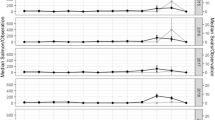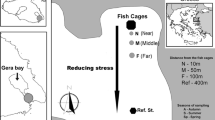Abstract
Broad scale survey distributions of fish are dominated by some extremely high catches. With a novel survey design we resolved the small-scale fish distribution in the spatio-temporal vicinity of these extreme hauls and showed that in the North Sea they generally do not occur in isolation. An additional case study where stomach contents of fish predators were analyzed revealed that they actually indicate aggregations of piscivorous fish predators on prey aggregations. We show that the predation impact can reach immense dimensions, an aggregation of more than 50 million juvenile cod (Gadus morhua) was entirely wiped out in 5 days by predatory whiting (Merlangius merlangus), aggregating on these juveniles in an area of approximately 18 km2. The consumption of only 32 hot spots of similar magnitude as observed in our study adds up to the average size of an incoming North Sea cod year class. These findings support the hypothesis of predation as the major source of mortality in young-of-the-year demersal fish species and questions the generality of fish aggregation as an effective anti-predator strategy. This study highlights the system-wide structuring force of small-scale predation hot spots and further points to the importance of a more realistic implementation of local high-intensity predation events in food web models.







Similar content being viewed by others
REFERENCES
Andersen NG. 1999. The effect of predator size, temperature, and prey characteristics on gastric evacuation in whiting. J Fish Biol 54:287–301
Bailey KM, Houde ED 1989. Predation on eggs and larvae of marine fishes and the recruitment problem. Adv Mar Biol 25:1–83
Beaugrand G, Brander K, Lindley JA, Souissi S, Reid PC. 2003. Plankton effect on cod recruitment in the North Sea. Nature 426:661–4
Blaxter JHS, Parrish BB. 1958. The effect of artificial lights on fish and other marine organisms at sea. Mar Res 2:24
Brown JH. 1984. On the relationship between abundance and distribution of species. Am Nat 124(2):225–79
Christensen V. 1983. Predation by sandeel on herring larvae. ICES CM (L:27)
Connell SD. 2000. Is there safety-in-numbers for prey? Oikos 88:527–32
Connell SD, Gillanders BM. 1997. Mortality and abundance of a schooling reef fish. Proc 8th Int Coral Reef Symp 8(1):1035–8
Ehrich S, Adlerstein S, Götz S, Mergardt N, Temming A. 1998. Variation in meso scale fish distribution in the North Sea. ICES CM J 25:14
Ehrich S, Adlerstein S, Brockmann U, Floeter J, Garthe S, Kröncke I, Neumann H, Reiss H, Sell AF, Stein M, Stelzenmüller V, Stransky C, Temming A, Wegner G, Zauke G-P. 2007. 20 years of the German small-scale bottom trawl survey (GSBTS): a review. Senckenb maritima 37(1):13–82
Floeter J, Temming A. 2003. Explaining diet composition of North Sea cod (Gadus morhua L.): prey size preference vs. prey availability. Can J Fish Aquat Sci 60:140–50
Floeter J, Temming A. 2005. Analysis of prey size preference of North Sea whiting, saithe and grey gurnard. ICES J Mar Sci 62:897–907
Floeter J, Kempf A, Vinther M, Schrum C, Temming A. 2005. Grey gurnard (Eutrigla gurnadus (L.)) in the North Sea: an emerging key predator? Can J Fish Aquat Sci 62:1853–64
Gini C. 1955. “Variabilità e mutabilità” (1912). Reprinted in Memorie di metodologica statistica. In: Pizetti E, Salvemini T, Eds. Rome: Libreria Eredi Virgilio Veschi
Heath MR, Gallego A, Hislop JR, Needle C, Scott B, Wright PJ. 1999. The importance of the late pelagic and demersal settlement phases for recruitment dynamics in North Sea haddock. ICES CM Y:11:6
Hislop J, Bromley PJ, Daan N, Gislason H, Heessen HJL, Robb AP, Skagen D, Sparholt H, Temming A. 1997. Database report of the stomach sampling project 1991. ICES Coop Res Rep 219:422
Hixon MA, Carr MH. 1997. Synergistic predation: density dependence, and population regulation in marine fish. Science 277:946–9
Houde ED. 1987. Fish early life dynamics and recruitment variability. Am Fish Soc Symp 2:17–29
Huse G, Toresen R. 2000. Juvenile herring prey on Barents Sea capelin larvae. Sarsia 85:385–91
ICES. 1996. Manual for the international bottom trawl surveys—revision V. ICES CM H:1 (addendum):58
ICES. 1999. Report of the workshop on gadoid stocks in the North Sea during the 1960s and 1970s—the fourth ICES/GLOBEC backward-facing workshop. ICES CM C:15:53
ICES. 2003. Report of the study group on multispecies assessments in the North Sea. ICES CM D:09:99
Jones R. 1974. The rate of elimination of food from the stomachs of haddock Melanogrammus aeglefinus, cod Gadus morhua and whiting Merlangius merlangus. Journal de Conseil, Conseil International pour l′Exploration de la Mer 3(35):225–43
Kokko H, Mackenzie A, Reynolds JD, Lindström J, Sutherland WJ. 1999. Measures of inequality are not equal. Am Nat 72(5):358–82
Laurel BJ, Gregory RS, Brown JA, Hancock JK, Schneider DC. 2004. Behavioural consequences of density-dependent habitat use in juvenile cod Gadus morhua and G. ogac: the role of movement and aggregation. Mar Ecol Prog Ser 272:257–70
Mergardt N, Temming A. 1997. Diel pattern of food intake in whiting (Merlangius merlangus) investigated from the weight of partly digested food particles in the stomach and laboratory determined particle decay functions. ICES J Mar Sci 54:226–42
Moore PD. 2001. Crowd trouble for predators. Nature 413:265–5
O’Brien CM, Fox CJ, Planque B, Casey J. 2000. Climate variability and North Sea cod. Nature 404:142
Parrish JK, Edelstein-Keshet L. 1999. Complexity, pattern, and evolutionary trade-offs in animal aggregation. Science 284:99–101
Patterson KR. 1985. The trophic ecology of whiting (Merlangius merlangus) in the Irish Sea and its significance to the Manx herring stock. Journal de Conseil, Conseil International pour l′Exploration de la Mer 42:152–61
Petitgas P. 1998. Biomass-dependent dynamics of fish spatial distributions characterized by geostatistical aggregation curves. ICES J Mar Sci 55:443–53
Pitcher TJ, Parrish JK. 1993. Functions of schoaling behaviour in teleosts. In: Pitcher TJ, Eds. Behaviour in teleost fishes. London: Chapman and Hall. p 363
Sogard SM. 1997. Size-selective mortality in the juvenile stage of teleost fishes: a review. Bull Mar Sci 60(3):1129–57
Temming A, Mergardt N. 2002. Estimating the mean time between meals in the field from stomach content data and gastric evacuation functions of whiting (Merlangius merlangius L.) feeding on sandeel (Ammodytes marinus Raitt). ICES J Mar Sci 59:782–93
Temming A, Götz S, Mergardt N, Ehrich S. 2004. Predation of whiting and haddock on sandeel: aggregative response, competition and diel periodicity. J Fish Biol 64(5):1351–72
Trenkel VM, Pinnegar JK, Dawson WA, de Buit MH, Tidd AN. 2005. Spatial and temporal structure of predator–prey relationships in the Celtic Sea fish community. Mar Ecol Prog Ser 299:257–68
Tupper M, Boutilier RG. 1995a. Effects of habitat on settlement, growth and postsettlement survival of Atlantic cod (Gadus morhua). Can J Fish Aquat Sci 52(9):1834–41
Tupper M, Boutilier RG. 1995b. Size and priority at settlement determine growth and competitive success of newly settled Atlantic cod. Mar Ecol Prog Ser 118:295–300
Wigley SE. 1996. The Lorenz curve method applied to NEFSC bottom trawl survey data. Northeast Fisheries Science Center Reference Document 96-05f
ACKNOWLEDGMENTS
Support for completion of the work was provided by two grants of the European Commission (FP 6 BECAUSE, UNCOVER). ICES for the submission of the IBTS data.
Author information
Authors and Affiliations
Corresponding author
Electronic supplementary material
Below is the link to the electronic supplementary material.
Rights and permissions
About this article
Cite this article
Temming, A., Floeter, J. & Ehrich, S. Predation Hot Spots: Large Scale Impact of Local Aggregations. Ecosystems 10, 865–876 (2007). https://doi.org/10.1007/s10021-007-9066-3
Received:
Accepted:
Published:
Issue Date:
DOI: https://doi.org/10.1007/s10021-007-9066-3




